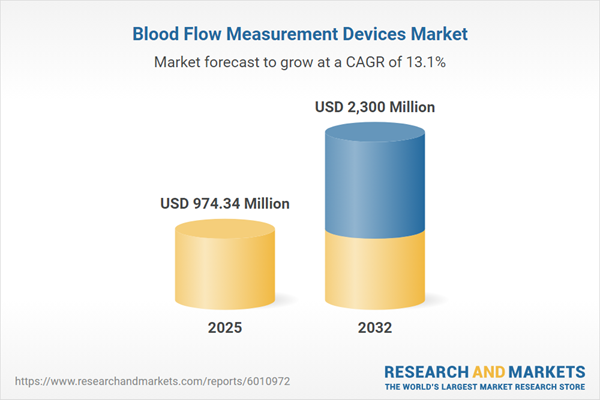Speak directly to the analyst to clarify any post sales queries you may have.
The blood flow measurement devices market is navigating a pivotal transformation, driven by technology innovation and the ongoing evolution of compliance mandates. Executives and senior management in healthcare technology and device manufacturing must remain responsive to these advancements to achieve enduring success.
Market Snapshot: Blood Flow Measurement Devices Market
In 2024, the blood flow measurement devices market reached a value of USD 861.50 million, propelled by heightened interest in vascular diagnostics and early health intervention. A compound annual growth rate (CAGR) of 13.06% underscores strong sector momentum, with forecasts showing growth to USD 974.34 million in 2025 and surpassing USD 2.30 billion by 2032. Demand spans clinical, research, and industrial settings, signaling the vital need for accurate blood flow analysis across patient care and process control. Flexible market adaptation, supported by agile engineering and regulatory preparedness, is now a prerequisite for organizations seeking to maintain competitive relevance globally.
Scope & Segmentation
This executive summary delivers strategic insights to support investment evaluation, technology adoption, and partnership formation within the blood flow measurement devices sector. Analysis of segmentation reveals emerging opportunities and critical focus areas for long-term planning:
- Technology Platforms: Electromagnetic, laser Doppler, imaging-based, thermal, and ultrasound systems enhance diagnostic capability while streamlining user operations for both clinical and industrial demands.
- Application Areas: Clinical monitoring, laboratory research, and industrial process control allow healthcare and manufacturing leaders to pursue improved decision-making and targeted outcomes through high-precision assessment.
- End Users: Clinics, hospitals, device manufacturers, research institutions, pharmaceutical companies, and biotechnology firms benefit from comprehensive relevance for diagnostics, therapy monitoring, and life science applications.
- Device Types: Console-based, portable, and wearable devices offer adaptable options that suit centralized institutions and distributed field teams, including those operating in resource-constrained environments.
- Geographic Coverage: Americas, Europe, Middle East & Africa, and Asia-Pacific each present unique patterns of technology adoption, compliance requirements, and infrastructure maturity, shaping tactical choices for market entry and partnership development.
- Market Leaders Profiled: General Electric Company, Samsung Medison Co., Ltd., Koninklijke Philips N.V., Siemens Healthcare GmbH, Canon Medical Systems Corporation, Shenzhen Mindray Bio-Medical Electronics Co., Ltd., Hitachi, Ltd., Esaote SpA, Edwards Lifesciences Corporation, and Terumo Corporation are profiled for their influence and innovation in the sector.
Key Takeaways for Senior Decision-Makers
- Real-time blood flow analytics enable healthcare and research organizations to streamline workflows and promote prompt clinical response in both centralized and mobile environments.
- Integrating artificial intelligence with wireless sensor networks addresses the operational demands of decentralized and remote healthcare delivery, offering scalable measurement solutions.
- Robust supply chain partnerships strengthen resiliency, supporting proactive compliance and consistent device availability amid regulatory and market shifts.
- Tailoring market strategies according to regional adoption pace and infrastructure maturity helps organizations differentiate offerings and effectively manage exposure to local risks.
- Deploying portable and wearable measurement devices enhances workflow efficiencies for distributed teams, especially where rapid deployment and adaptability are mission-critical.
- Ongoing investment in advanced measurement platforms equips organizations to address evolving medical standards and regulatory expectations.
Tariff Impact: Navigating the 2025 Trade Policy Shift
Impending tariffs on blood flow measurement device components are prompting manufacturers to reinforce local production and increase engagement with regulators. These strategic moves are essential to maintain cost stability and ensure reliable device access under evolving global trade conditions.
Methodology & Data Sources
This report synthesizes evidence from peer-reviewed publications, targeted industry interviews, and collaborative workshops across healthcare and manufacturing sectors. Such a multi-source approach ensures that every recommendation reflects the perspectives of both clinical leaders and technology providers.
Why This Report Matters
- Provides executive teams with actionable insights for compliance management, risk anticipation, and emerging demand assessment across diverse healthcare segments.
- Guides procurement and investment leaders to build data-backed, agile growth strategies to sharpen competitive positioning.
- Delivers targeted market intelligence for organizations seeking to capitalize on new opportunities and improve operational productivity.
Conclusion
By harnessing this analysis, organizations are positioned to navigate regulatory change, drive technology implementation, and achieve sustainable expansion within the evolving blood flow measurement devices landscape.
Additional Product Information:
- Purchase of this report includes 1 year online access with quarterly updates.
- This report can be updated on request. Please contact our Customer Experience team using the Ask a Question widget on our website.
Table of Contents
3. Executive Summary
4. Market Overview
7. Cumulative Impact of Artificial Intelligence 2025
Companies Mentioned
The companies profiled in this Blood Flow Measurement Devices market report include:- General Electric Company
- Samsung Medison Co., Ltd.
- Koninklijke Philips N.V.
- Siemens Healthcare GmbH
- Canon Medical Systems Corporation
- Shenzhen Mindray Bio-Medical Electronics Co., Ltd.
- Hitachi, Ltd.
- Esaote SpA
- Edwards Lifesciences Corporation
- Terumo Corporation
Table Information
| Report Attribute | Details |
|---|---|
| No. of Pages | 195 |
| Published | October 2025 |
| Forecast Period | 2025 - 2032 |
| Estimated Market Value ( USD | $ 974.34 Million |
| Forecasted Market Value ( USD | $ 2300 Million |
| Compound Annual Growth Rate | 13.0% |
| Regions Covered | Global |
| No. of Companies Mentioned | 11 |









